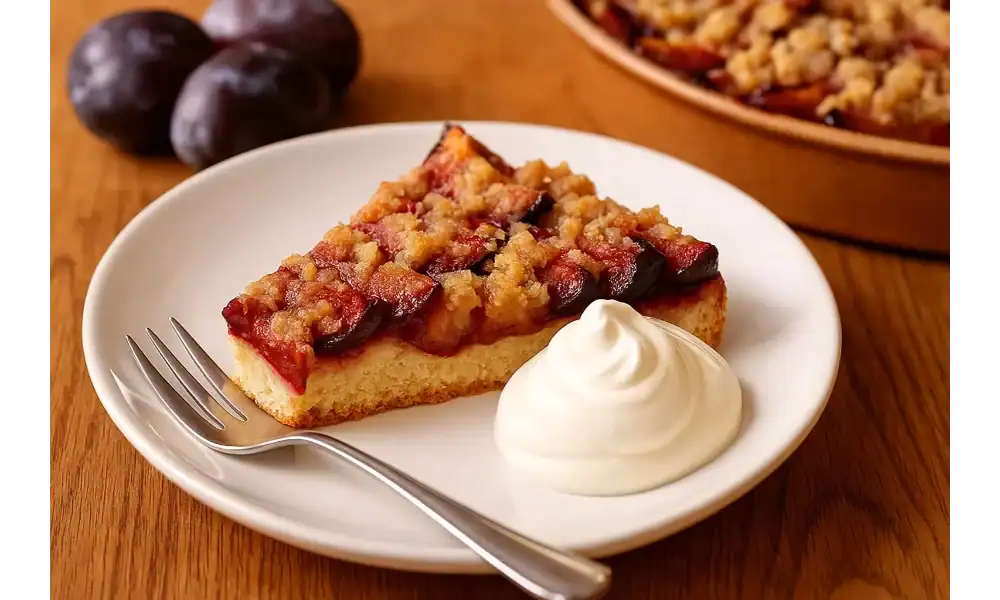Introduction
German Plum Cake, also known as Zwetschgenkuchen, is a classic treat from Germany. Families bake it every year when plums fill the markets in late summer and fall. It is more than just a cake; it is part of the Kaffee und Kuchen tradition, where friends and family gather to enjoy coffee and homemade desserts.
This authentic German Plum Cake recipe is simple, quick, and full of flavor. You do not need to be a professional baker. With a handful of fresh plums, a soft base, and a sweet streusel topping, you can bake a dessert that looks rustic but tastes like something from a bakery in Bavaria.
People love this cake because it is easy to make at home and perfect for every occasion. It works for a Sunday family gathering, a cozy afternoon snack, or even as a holiday dessert. The rich taste of plums pairs beautifully with a buttery crust and crumbly streusel, making each bite both sweet and slightly tart.
In this guide, you will get clear step-by-step instructions. You will also find easy tips, delicious variations, and answers to the most common questions about making German Plum Cake. So, get ready to bake your own Zwetschgenkuchen and bring the taste of Germany into your kitchen.
For a variety of cake recipes, try our:
- How to Make the Best Crabcakes: Crispy, Juicy & Full of Flavor
- How to Make the Perfect Polenta Cake (Moist & Flavorful Recipe)
- How to Make the Best Corn Cakes at Home (Easy & Crispy Recipe)
- Corn Cakes vs Rice Cakes: Which One Fits Your Diet Better?
- How to Make the Best Plum Cake at Home – Simple Step-by-Step Guide
What is German Plum Cake (Zwetschgenkuchen)?
Meaning of Zwetschgen and the Difference from Regular Plums
Zwetschgen are small, oval European plums. They are darker, firmer, and less juicy than round supermarket plums. Because of this, they hold their shape while baking and give the cake a rich, slightly tart flavor. This makes them perfect for an authentic German Plum Cake recipe.
History and Cultural Significance in German Baking
German Plum Cake, or Zwetschgenkuchen, has a long history. Families have baked it for centuries during plum season. It is more than food; it is a tradition that brings people together. Every year, bakeries across Germany fill their windows with slices of this cake, making it a true symbol of German baking.
Regional Variations: Yeast Dough vs. Shortcrust
In southern Germany, people often bake this cake with a light yeast dough. In other regions, bakers prefer a buttery shortcrust base. Both versions taste delicious, but yeast dough gives a fluffy bite, while shortcrust feels rich and crisp. Many home bakers even add streusel for extra crunch.
Why This Cake is Often Served with Kaffee und Kuchen
In Germany, afternoons are for Kaffee und Kuchen. Families and friends meet to drink coffee and share cakes. German Plum Cake is one of the favorites during this tradition because it tastes best fresh and warm. It also pairs perfectly with coffee or tea, making it a must-have at the table.
Differences Between German Plum Cake and Other Fruit Cakes
Unlike many fruit cakes, German Plum Cake uses fresh plums, not dried fruit. The plums bake into a soft and juicy layer that balances sweet and sour. Other fruit cakes are often heavy, but Zwetschgenkuchen is light, airy, and easy to enjoy in large slices. This makes it stand out as a simple yet elegant dessert.
Ingredients You’ll Need

Fresh Plums (Zwetschgen/Italian Plums) and How to Choose Ripe Ones
The heart of every authentic German Plum Cake is fresh Zwetschgen/ Italian plums. These small, dark Italian plums are firm and slightly tart. Always pick ripe ones that feel soft but not mushy. Their rich flavor and texture make the cake taste true to tradition.
Dough Base Options – Yeast, Shortcrust, or Simple Cake Batter
You can bake this cake with different bases. A yeast dough gives a light and fluffy bite. A shortcrust base feels buttery and crisp. For a quick version, you can also use a simple cake batter. Each option makes a delicious German Plum Cake, so choose the style you prefer.
Streusel Topping – Flour, Butter, Sugar
A good Zwetschgenkuchen often comes with a sweet streusel topping. It is made with flour, cold butter, and sugar. The topping bakes into golden crumbs that add crunch and sweetness. Streusel also balances the tartness of the plums.
Flavor Enhancers – Cinnamon, Vanilla, Lemon Zest
Spices and aromas make the cake unforgettable. Cinnamon adds warmth. Vanilla brings a soft sweetness. Lemon zest gives a fresh note. These simple touches make the authentic German Plum Cake even more flavorful.
Substitutions for Dietary Preferences (Gluten-Free, Vegan)
You can easily adjust this cake to fit your diet. Use gluten-free flour mixes for the dough. Replace butter with vegan margarine and eggs with applesauce or flaxseed gel. These changes still give you a rich and tasty German Plum Cake at home.
Step-by-Step Instructions
Preparing and Slicing Plums Correctly
Wash the plums well and dry them with a clean towel. Cut each plum in half and remove the pit. Slice them into quarters if they are large. Always keep the skin on because it gives flavor and color. Ripe Zwetschgen plums hold their shape and bake beautifully in the cake.
Making the Dough – Yeast Rising or Quick Batter Option
For a classic German Plum Cake, prepare a soft yeast dough. Let it rise in a warm place until it doubles in size. If you want a faster option, mix a simple cake batter with flour, sugar, eggs, and butter. Both bases taste great, so choose the method that fits your time.
Arranging Plums in a Traditional Overlapping Pattern
Place the plum slices in rows over the dough. Always overlap them slightly so the cake looks full and rich. This traditional pattern makes the cake bake evenly and look beautiful. A well-arranged plum layer also gives every slice a juicy taste.
Adding Streusel Topping for Crunch
Mix flour, sugar, and cold butter to make streusel. Use your fingers to crumble it over the plums. The streusel will bake into golden, crunchy bits. It adds sweetness and balances the tart flavor of the fruit.
Baking Time, Temperature, and Doneness Check
Bake the cake at 180°C (350°F) for about 40–50 minutes. The crust should look golden, and the plums should bubble slightly. Insert a toothpick into the dough. If it comes out clean, your Zwetschgenkuchen is ready. Let it cool a little before serving.
Tips, Variations & Serving Ideas

How to Prevent Soggy Bottoms
Plums release juice while baking, so the cake can get soggy. To stop this, drain sliced plums for a few minutes before using them. You can also dust the dough with fine breadcrumbs or ground nuts. This layer absorbs extra juice and keeps the base firm.
Adding Almonds or Walnuts for Extra Texture
Nuts bring crunch and flavor to German Plum Cake. Sprinkle sliced almonds or chopped walnuts on top of the streusel before baking. They toast in the oven and add a nutty aroma. This simple step makes every bite more exciting.
Serving with Whipped Cream, Vanilla Ice Cream, or Custard
German Plum Cake tastes great on its own, but it shines with extras. Serve warm slices with fresh whipped cream for a light touch. Add vanilla ice cream for a classic pairing. You can also enjoy it with creamy custard for a rich dessert.
Turning Leftovers into a Breakfast Treat
Do not waste leftover cake. Enjoy it the next morning as a sweet breakfast. Pair it with coffee or tea for a quick meal. The plums taste even better after sitting overnight, making it a cozy start to the day.
Variations with Other Fruits
If plums are out of season, you can try other fruits. Apricots add a bright flavor. Cherries bring sweetness, while apples give a classic taste. Each variation creates a new twist on the authentic German Plum Cake recipe.
Storage & Make-Ahead Tips
How Long German Plum Cake Lasts at Room Temperature
German Plum Cake stays fresh at room temperature for up to two days. Keep it in a cool, dry place. Cover it lightly with a clean towel so it does not dry out. This way, the crust stays crisp and the plums remain juicy.
Refrigeration Guidelines for Freshness
If you want to keep the cake longer, store it in the fridge. Place it in an airtight container and enjoy it within four days. The cool air keeps the plums fresh, and the cake will still taste delicious. Always bring it to room temperature before serving for the best flavor.
Freezing Instructions (Whole or Sliced)
You can freeze German Plum Cake for up to three months. Wrap the whole cake in plastic wrap, then add a layer of foil. For easier use, freeze slices separately. Place parchment paper between slices to stop them from sticking. This makes thawing simple and quick.
How to Reheat While Keeping the Texture
Warm slices in the oven at 150°C (300°F) for about 10 minutes. This keeps the crust crisp and the plums soft. Avoid the microwave because it makes the base soggy. A short reheat in the oven brings back the fresh-baked taste.
Best Storage Containers (Airtight vs. Plastic Wrap)
For short storage, wrap the cake in plastic wrap or foil. For longer freshness, use airtight containers. Airtight storage keeps out moisture and preserves flavor. Choose the method that fits your needs, and your authentic German Plum Cake will stay delicious.
FAQs
Authentic German Plum Cake

Authentic German Plum Cake
Ingredients
Method
- Prep the plums: Wash, halve, and pit the plums. Slice them into quarters if large. Set aside.
- Make the dough: In a bowl, beat butter and sugar until creamy. Add the egg and vanilla. Mix in flour, baking powder, and salt until smooth. Spread the dough evenly into a greased 20 cm (8-inch) baking pan.
- Arrange the plums: Place the plum slices on top in rows, slightly overlapping for a traditional look. Sprinkle lightly with cinnamon.
- Make the streusel (optional): Rub flour, sugar, and cold butter together with your fingers until crumbly. Sprinkle over the plums.
- Bake: Bake in a preheated oven at 180°C (350°F) for 35–40 minutes, or until golden and the plums are bubbling slightly.
- Serve: Let cool a little, then serve warm. Pair with whipped cream or vanilla ice cream.
1. What is German Plum Cake?
German Plum Cake, or Zwetschgenkuchen, is a traditional German dessert made with fresh plums, a soft dough base, and often a streusel topping.
2. What kind of plums should I use?
Use Zwetschgen or Italian plums. They are small, oval, and less juicy, which makes them perfect for baking.
3. Can I use regular plums instead?
Yes, you can, but regular plums are juicier. To prevent soggy cake, drain them well or add breadcrumbs to the base.
4. Should I use yeast dough or shortcrust for German Plum Cake?
Both work well. Yeast dough gives a fluffy base, while shortcrust makes it rich and crisp. Choose the style you like best.
5. What toppings go well with German Plum Cake?
Serve it with whipped cream, vanilla ice cream, or warm custard. These pairings balance the tartness of the plums.
Conclusion
German Plum Cake, or Zwetschgenkuchen, is more than just a dessert. It carries the charm of German baking and the warmth of family traditions. The juicy plums, the soft base, and the sweet streusel make it a cake that people love to enjoy year after year.
Plum season is the perfect time to try this recipe at home. Fresh fruit gives the cake its rich flavor and makes it taste truly authentic. You do not need advanced skills, only simple ingredients and easy steps.
You can also explore new ways to enjoy it. Add nuts for crunch, serve it with cream or ice cream, or try it with other fruits like cherries or apples. Each variation gives you a new experience while keeping the spirit of the original cake alive.
So, do not wait for the bakery to make it for you. Bake this Zwetschgenkuchen at home and bring a taste of Germany to your kitchen!
For more recipes, try our:

